Stanford CS336 assignment1 | Transformer Language Model Architecture
Transformer Language Model Architecture
- 零、 环境设置
- 一、 Basic Building Blocks: Linear and Embedding Modules
- Parameter Initialization 初始化参数
- Linear Module 线性模块
- Embedding module
- 二、 Pre-Norm Transformer Block
- Root Mean Square Layer Normalization
- Position-Wise Feed-Forward Network
- Relative Positional Embeddings
- Scaled Dot-Product Attention
- Causal Multi-Head Self-Attention
- 三、 The Full Transformer LM
- Transformer block
- Transformer LM
- 四、 总结
零、 环境设置
我们每次都去激活环境太繁琐这里建议直接把激活环境的命令写进.bashrc文件
找到家目录下的.bashrc文件
然后找到项目根目录下面有一个.venv文件

.venv目录下有一个bin,然后bin中有一个activate脚本,这个脚本就是用来激活uv环境的,我们只需要在每次打开终端也就是shell启动的时候执行一遍这个脚本就好了。

其实就是在.bashrc文件中加上一句source命令
source /root/css336/.venv/bin/activate # 这个路径文件需要和自己uv环境所在路径对应
一、 Basic Building Blocks: Linear and Embedding Modules
Parameter Initialization 初始化参数
根据之前深度学习基础,模型参数的初始化对于模型训练是很重要的,参数初始化的不好会引起梯度消失或梯度爆炸。
这里初始化采用截断高斯分布,来避免参数值过大或过小。
线性层(Linear weights):N(μ=0,σ=2din+dout)\mathcal{N}(\mu=0, \sigma=\frac{2}{d_{in} + d_{out}})N(μ=0,σ=din+dout2) 截断[−3σ,+3σ][-3\sigma,+3\sigma][−3σ,+3σ]
嵌入层(embedding):N(μ=0,σ=1)\mathcal{N}(\mu=0, \sigma=1)N(μ=0,σ=1) 截断[−3,+3][-3,+3][−3,+3]
具体的实现是使用pytorch中的torch.nn.init.trunc_normal。torch.nn.init.trunc_normal会从正态分布中采样,如果采样得到的结果落在截断范围外则丢弃重新进行采样,直到所有值均落在截断范围内。
就比如上面嵌入层embedding的初始化
torch.nn.init.trunc_normal_(tensor,mean=0.0,std=1.0,a=-3.0,b=3.0
)
| 参数 | 类型 | 默认值 | 说明 |
|---|---|---|---|
| tensor | Tensor | — | 要初始化的张量(in-place 操作) |
| mean | float | 0.0 | 正态分布的均值 |
| std | float | 1.0 | 正态分布的标准差 |
| a | float | -3.0 | 截断下界(以标准差为单位) |
| b | float | 3.0 | 截断上界(以标准差为单位) |
Linear Module 线性模块
import torch
from torch import nn
from torch.nn.init import trunc_normal_
from einops import einsumclass Linear(nn.Module):def __init__(self,in_features: int,out_features: int,device = None,dtype = None):super().__init__()self.in_features = in_featuresself.out_features = out_featuresfactory_kwargs = {'device': device, 'dtype': dtype}self.W = nn.Parameter(torch.empty(out_features, in_features, **factory_kwargs))std = (2 / (in_features + out_features)) ** 0.5trunc_normal_(self.W, mean=0.0, std=std, a=-3.0*std, b=3.0*std)def forward(self, x: torch.Tensor) -> torch.Tensor:return einsum(x, self.W, '... in, out in -> ... out')
编写adapter.py进行测试
import layer
def run_linear(d_in: int,d_out: int,weights: Float[Tensor, " d_out d_in"],in_features: Float[Tensor, " ... d_in"],
) -> Float[Tensor, " ... d_out"]:"""Given the weights of a Linear layer, compute the transformation of a batched input.Args:in_dim (int): The size of the input dimensionout_dim (int): The size of the output dimensionweights (Float[Tensor, "d_out d_in"]): The linear weights to usein_features (Float[Tensor, "... d_in"]): The output tensor to apply the function toReturns:Float[Tensor, "... d_out"]: The transformed output of your linear module."""device, dtype = in_features.device, in_features.dtypemodel = layer.Linear(d_in, d_out, device, dtype)model.load_state_dict({'W': weights})return model.forward(in_features)
进入test目录中然后执行
pytest test_model.py::test_linear
在进行执行前
测试通过后会显示下面的结果。

这里面涉及一些einops和nn.Parameter的用法。
Embedding module
embdding的初始化也是使用torch.nn.init.trunc_normal函数

class Embedding(nn.Module):def __init__(self,num_embeddings: int,embedding_dim: int,device: torch.device | None = None,dtype: torch.dtype | None = None):super().__init__()self.num_embeddings = num_embeddingsself.embedding_dim = embedding_dimfactory_kwargs = {'device': device, 'dtype': dtype}self.W = nn.Parameter(torch.empty(num_embeddings, embedding_dim, **factory_kwargs))std = 1trunc_normal_(self.W, mean=0.0, std=std, a=-3.0*std, b=3.0*std)def forward(self, token_ids: torch.Tensor) -> torch.Tensor:return self.W[token_ids]
编写测试adapter
def run_embedding(vocab_size: int,d_model: int,weights: Float[Tensor, " vocab_size d_model"],token_ids: Int[Tensor, " ..."],
) -> Float[Tensor, " ... d_model"]:"""Given the weights of an Embedding layer, get the embeddings for a batch of token ids.Args:vocab_size (int): The number of embeddings in the vocabularyd_model (int): The size of the embedding dimensionweights (Float[Tensor, "vocab_size d_model"]): The embedding vectors to fetch fromtoken_ids (Int[Tensor, "..."]): The set of token ids to fetch from the Embedding layerReturns:Float[Tensor, "... d_model"]: Batch of embeddings returned by your Embedding layer."""device, dtype = weights.device, weights.dtypemodel = layer.Embedding(vocab_size, d_model, device, dtype)model.load_state_dict({'W': weights})return model.forward(token_ids)
测试
pytest test_model.py::test_embedding
测试通过后会显示下面的结果。
二、 Pre-Norm Transformer Block
Root Mean Square Layer Normalization
我们要实现的transformer和原论文中的transformer的结构并不相同,就比如normliaztion,这里使用的是pre-norm,pre-norm被认为能改善梯度流(因为原始的数据是没有经过任何处理直接通过residual加到最后的结果)具体参考Stanford CS336 Lecture3 | Architectures, hyperparameters。
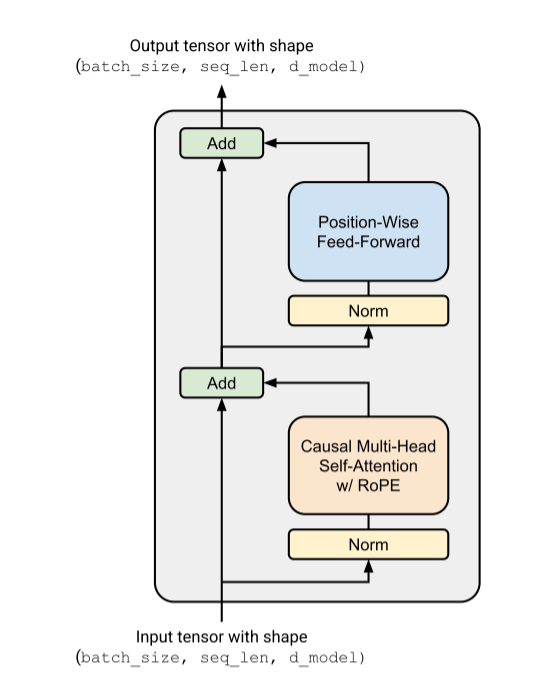
关于RMSNorm的原理

aia_iai为一个(dmodel,)(d_{model}, )(dmodel,)维的activation,g是可学习的增益参数。
class RMSNorm(nn.Module):def __init__(self,d_model: int,eps: float = 1e-5,device: torch.device | None = None,dtype: torch.dtype | None = None):super().__init__()self.d_model = d_modelself.eps = epsfactory_kwargs = {'device': device, 'dtype': dtype}self.W = nn.Parameter(torch.ones(d_model, **factory_kwargs))def forward(self, x: torch.Tensor) -> torch.Tensor:in_dtype = x.dtypex = x.to(torch.float32)RMS = (x.pow(2).mean(dim=-1, keepdim=True) + self.eps).sqrt()x /= RMSx *= self.Wreturn x.to(in_dtype)
adapters
def run_rmsnorm(d_model: int,eps: float,weights: Float[Tensor, " d_model"],in_features: Float[Tensor, " ... d_model"],
) -> Float[Tensor, " ... d_model"]:"""Given the weights of a RMSNorm affine transform,return the output of running RMSNorm on the input features.Args:d_model (int): The dimensionality of the RMSNorm input.eps: (float): A value added to the denominator for numerical stability.weights (Float[Tensor, "d_model"]): RMSNorm weights.in_features (Float[Tensor, "... d_model"]): Input features to run RMSNorm on. Can have arbitrary leadingdimensions.Returns:Float[Tensor,"... d_model"]: Tensor of with the same shape as `in_features` with the output of runningRMSNorm of the `in_features`."""device, dtype = weights.device, weights.dtypemodel = layer.RMSNorm(d_model, eps, device, dtype)model.load_state_dict({'W': weights})return model.forward(in_features)
测试
pytest test_model.py::test_rmsnorm

Position-Wise Feed-Forward Network
这里实现的是经过改进的FFN,加入了门控,同时激活函数使用SiLU 或者Swish。
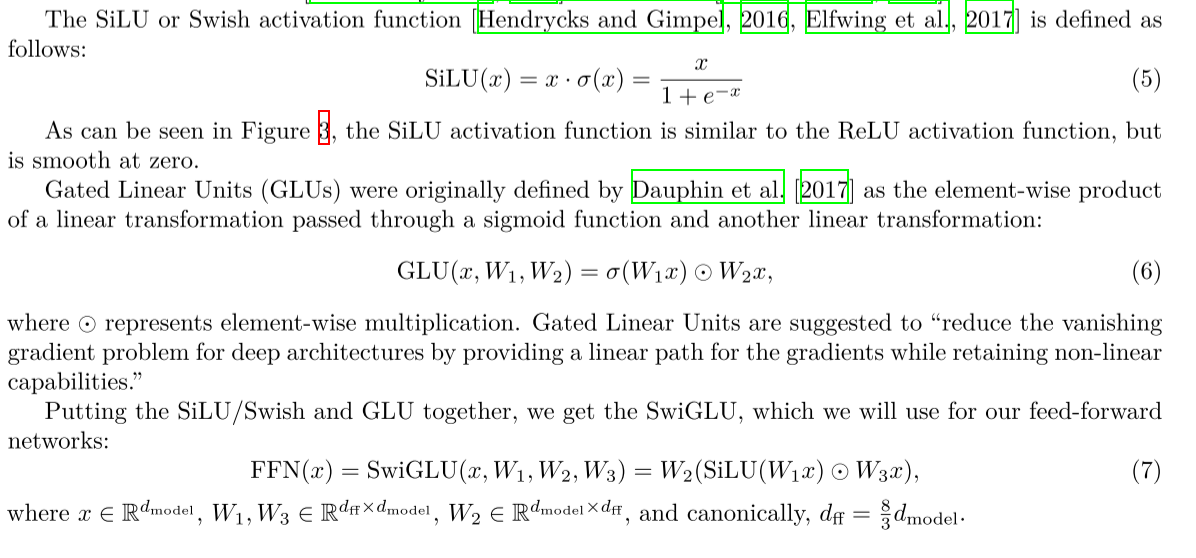
上面都是列向量表示,因为在pytorch中是行优先存储的原则,所以这里需要对上面的公式进行相关修改
GLU(x,W1,W2)=σ(xW1T)⊙(xW2T)GLU(x, W_1, W_2)=\sigma(xW_1^T) \odot (xW_2^T)GLU(x,W1,W2)=σ(xW1T)⊙(xW2T)
FFN(x)=SwiGLU(x,W1,W2,W3)=(SiLU(xW1T)⊙(xW3T))W2TFFN(x)=SwiGLU(x,W_1,W_2,W_3)=(SiLU(xW_1^T) \odot (xW_3^T))W_2^TFFN(x)=SwiGLU(x,W1,W2,W3)=(SiLU(xW1T)⊙(xW3T))W2T
同时dff=83dmodeld_{ff}=\frac{8}{3} d_{model}dff=38dmodel,这个原因主要是为了保持参数量一致和原FFN,具体可以参考Stanford CS336 Lecture3 | Architectures, hyperparameters或者lecture 3的视频和ppt中均有解释。
实现如下:assignment1的pdf中有说可以使用torch.sigmoid,这里直接使用了没有自己手动实现sigmoid函数。
def SiLU(x: torch.Tensor) -> torch.Tensor:return x * torch.sigmoid(x)class SwiGLU(nn.Module):def __init__(self,d_model: int,d_ff: int,device: torch.device | None = None,dtype: torch.dtype | None = None):super().__init__()self.d_model = d_modelself.d_ff = d_fffactory_kwargs = {'device': device, 'dtype': dtype}self.linear1 = Linear(d_model, d_ff)self.linear2 = Linear(d_ff, d_model)self.linear3 = Linear(d_model, d_ff)def forward(self, x: Float[torch.Tensor, "... d_model"]) -> Float[torch.Tensor, "... d_model"]:xW1 = self.linear1(x)xW3 = self.linear3(x)return self.linear2(SiLU(xW1) * xW3)
adapters中
def run_swiglu(d_model: int,d_ff: int,w1_weight: Float[Tensor, " d_ff d_model"],w2_weight: Float[Tensor, " d_model d_ff"],w3_weight: Float[Tensor, " d_ff d_model"],in_features: Float[Tensor, " ... d_model"],
) -> Float[Tensor, " ... d_model"]:"""Given the weights of a SwiGLU network, returnthe output of your implementation with these weights.Args:d_model (int): Dimensionality of the feedforward input and output.d_ff (int): Dimensionality of the up-project happening internally to your swiglu.w1_weight (Float[Tensor, "d_ff d_model"]): Stored weights for W1w2_weight (Float[Tensor, "d_model d_ff"]): Stored weights for W2w3_weight (Float[Tensor, "d_ff d_model"]): Stored weights for W3in_features (Float[Tensor, "... d_model"]): Input embeddings to the feed-forward layer.Returns:Float[Tensor, "... d_model"]: Output embeddings of the same shape as the input embeddings."""# Example:# If your state dict keys match, you can use `load_state_dict()`# swiglu.load_state_dict(weights)# You can also manually assign the weights# swiglu.w1.weight.data = w1_weight# swiglu.w2.weight.data = w2_weight# swiglu.w3.weight.data = w3_weightdevice, dtype = w1_weight.device, w1_weight.dtypemodel = layer.SwiGLU(d_model, d_ff, device, dtype)model.load_state_dict({"linear1.W": w1_weight,"linear2.W": w2_weight,"linear3.W": w3_weight,})return model.forward(in_features)
测试命令
pytest test_model.py::test_swiglu

还需要测试一下SiLU
pytest test_model.py::test_silu_matches_pytorch

Relative Positional Embeddings
数学上实现RoPE是通过旋转矩阵,对于给定的一个query token q(i)=Wqx(i)∈Rdq^{(i)} = W_qx^{(i)} \in \mathbb{R}^dq(i)=Wqx(i)∈Rd,query token的位置为i,可以使用成对的旋转矩阵(偶数) RiR^iRi 给query token加入位置信息后 q′(i)=Riq(i)=RiWqx(i)q^{'(i)}=R^iq^{(i)}=R^i W_qx^{(i)}q′(i)=Riq(i)=RiWqx(i)
这里,RiR_iRi会将嵌入向量中每一对元素q(i)2k:2k+1q(i)_{2k:2k+1}q(i)2k:2k+1视为一个二维向量,并将其旋转一个角度θi,k=iΘ2k/d\theta_{i,k}=\frac{i}{\Theta^{2k/d}}θi,k=Θ2k/di,其中k={0,1,2,d/2}k=\{0, 1, 2,d/2\}k={0,1,2,d/2},而Θ\ThetaΘ是一个常数,通常取1000,可以将整个旋转矩阵视为一个分块对角矩阵,其对角线上包含d2个2×2\frac{d}{2}个 2 \times 22d个2×2旋转块Ri,kR_{i,k}Ri,k
Rki=[cos(θi,k)−sin(θi,k)sin(θi,k)cos(θi,k)]R_k^i=\begin{bmatrix} cos(\theta_{i, k})& -sin(\theta_{i, k})\\ sin(\theta_{i, k}) & cos(\theta_{i, k}) \end{bmatrix}Rki=[cos(θi,k)sin(θi,k)−sin(θi,k)cos(θi,k)]
Ri=[R1i00⋯00R2i0⋯000R3i⋯0⋮⋮⋮⋱⋮000⋯Rd/2i]R^i = \begin{bmatrix} R_1^i & 0 & 0 & \cdots & 0 \\ 0 & R_2^i & 0 & \cdots & 0 \\ 0 & 0 & R_3^i & \cdots & 0 \\ \vdots & \vdots & \vdots & \ddots & \vdots \\ 0 & 0 & 0 & \cdots & R_{d/2}^i \end{bmatrix}Ri=R1i00⋮00R2i0⋮000R3i⋮0⋯⋯⋯⋱⋯000⋮Rd/2i
上面是RoPE的数学原理,但是实际上实现RoPE时,并不会显示构造旋转矩阵,因为这样效率比较低,通常是构造cos、sin矩阵然后再分奇偶应用,具体操作如下:
先根据θi,k=iΘ2k/d\theta_{i,k}=\frac{i}{\Theta^{2k/d}}θi,k=Θ2k/di,其中k={0,1,2,d/2}k=\{0, 1, 2,d/2\}k={0,1,2,d/2} 构造θi,k\theta_{i,k}θi,k矩阵,这里可以使用torch.arange生成关于1Θ2k/d\frac{1}{\Theta^{2k/d}}Θ2k/d1的向量
freq = 1.0 / (theta ** (torch.arange(0, d - 1, 2) / d))
然后使用torch.outer,对每个位置和freq做外积得到矩阵
positions = torch.arange(0, max_seq_len, device=device).float()
freqs = torch.outer(positions, freq)
我们可以先忽略批次操作因为前面的维度不会对计算产生影响
下面构造sin、cos矩阵
self.register_buffer('cos_cache', torch.cos(torch.tensor(freqs)))
self.register_buffer('sin_cache', torch.sin(torch.tensor(freqs)))
假设对于第i个token只有两维,即dmodel=2d_{model}=2dmodel=2
[x0,x1]×[cos(θi,0)−sin(θi,0)sin(θi,0)cos(θi,0)]=[x0cos+x1sin,−x0sin+x1cos]\begin{bmatrix}x_0, x_1\end{bmatrix} \times \begin{bmatrix} cos(\theta_{i, 0})& -sin(\theta_{i, 0})\\ sin(\theta_{i, 0}) & cos(\theta_{i, 0}) \end{bmatrix}=\begin{bmatrix}x_0cos + x_1sin, -x_0sin+x_1cos\end{bmatrix}[x0,x1]×[cos(θi,0)sin(θi,0)−sin(θi,0)cos(θi,0)]=[x0cos+x1sin,−x0sin+x1cos]
[x2,x3]×[cos(θi,1)−sin(θi,1)sin(θi,1)cos(θi,1)]=[x2cos+x3sin,−x2sin+x3cos]\begin{bmatrix}x_2, x_3\end{bmatrix} \times \begin{bmatrix} cos(\theta_{i, 1})& -sin(\theta_{i, 1})\\ sin(\theta_{i, 1}) & cos(\theta_{i, 1}) \end{bmatrix}=\begin{bmatrix}x_2cos + x_3sin, -x_2sin+x_3cos\end{bmatrix}[x2,x3]×[cos(θi,1)sin(θi,1)−sin(θi,1)cos(θi,1)]=[x2cos+x3sin,−x2sin+x3cos]
如果我们单独把偶数、奇数拿出来,然后再还原回去就对token i完成了处理。
也就是[x0,x2,x4,...xd/2]⊗[cos(θi,0),cos(θi,1),cos(θi,2),....cos(θi,d/2)]+[x1,x3,x5,...xd/2−1]⊗[sin(θi,0),sin(θi,1),sin(θi,2),....sin(θi,d/2)][x_0, x_2, x_4,...x_{d/2}] \otimes [cos(\theta_{i,0}),cos(\theta_{i,1}),cos(\theta_{i,2}),....cos(\theta_{i,d/2})] + [x_1, x_3, x_5,...x_{d/2-1} ]\otimes [sin(\theta_{i,0}),sin(\theta_{i,1}),sin(\theta_{i,2}),....sin(\theta_{i,d/2})][x0,x2,x4,...xd/2]⊗[cos(θi,0),cos(θi,1),cos(θi,2),....cos(θi,d/2)]+[x1,x3,x5,...xd/2−1]⊗[sin(θi,0),sin(θi,1),sin(θi,2),....sin(θi,d/2)]即为结果的偶数项
[x0,x2,x4,...xd/2]⊗−[sin(θi,0),sin(θi,1),sin(θi,2),....sin(θi,d/2)]+[x1,x3,x5,...xd/2−1]⊗[cos(θi,0),cos(θi,1),cos(θi,2),....cos(θi,d/2)][x_0, x_2, x_4,...x_{d/2}] \otimes - [sin(\theta_{i,0}),sin(\theta_{i,1}),sin(\theta_{i,2}),....sin(\theta_{i,d/2})] + [x_1, x_3, x_5,...x_{d/2-1} ]\otimes [cos(\theta_{i,0}),cos(\theta_{i,1}),cos(\theta_{i,2}),....cos(\theta_{i,d/2})][x0,x2,x4,...xd/2]⊗−[sin(θi,0),sin(θi,1),sin(θi,2),....sin(θi,d/2)]+[x1,x3,x5,...xd/2−1]⊗[cos(θi,0),cos(θi,1),cos(θi,2),....cos(θi,d/2)]为结果的奇数项
于是就可以按上述方法实现。
class RotaryPositionalEmbedding(nn.Module):def __init__(self,theta: float,d_k: int,max_seq_len: int,device = None):super().__init__()self.theta = thetaassert d_k % 2 == 0, 'd_k is not even'self.d_k = d_kself.max_seq_len = max_seq_lenfactory_kwargs = {'device': device}freq = 1.0 / (theta ** (torch.arange(0, d_k, 2, device=device).float() / d_k))positions = torch.arange(0, max_seq_len, device=device).float()freqs = torch.outer(positions, freq)self.register_buffer('cos_cache', torch.cos(torch.tensor(freqs))) self.register_buffer('sin_cache', torch.sin(torch.tensor(freqs))) def forward(self,x: Float[torch.Tensor, "... seq_len d_k"],token_positions: Int[torch.Tensor, "... seq_len"]) -> Float[torch.Tensor, "... seq_len d_k"]:sin = self.sin_cache[token_positions]cos = self.cos_cache[token_positions]x_even = x[..., ::2]x_odd = x[..., 1::2]out_even = x_even * cos - x_odd * sinout_odd = x_even * sin + x_odd * cosout = torch.empty_like(x)out[..., ::2] = out_evenout[..., 1::2] = out_oddreturn out
这里面还有一些内容如register_buffer的使用,以及pytorch的广播机制、二维tensor也可以作为索引的内容需要去补充、以及torch.empty_like的用法
adapters的编写
def run_rope(d_k: int,theta: float,max_seq_len: int,in_query_or_key: Float[Tensor, " ... sequence_length d_k"],token_positions: Int[Tensor, " ... sequence_length"],
) -> Float[Tensor, " ... sequence_length d_k"]:"""Run RoPE for a given input tensor.Args:d_k (int): Embedding dimension size for the query or key tensor.theta (float): RoPE parameter.max_seq_len (int): Maximum sequence length to pre-cache if your implementation does that.in_query_or_key (Float[Tensor, "... sequence_length d_k"]): Input tensor to run RoPE on.token_positions (Int[Tensor, "... sequence_length"]): Tensor of shape (batch_size, sequence_length) with the token positionsReturns:Float[Tensor, " ... sequence_length d_k"]: Tensor with RoPEd input."""device = in_query_or_key.devicemodel = layer.RotaryPositionalEmbedding(theta, d_k, max_seq_len, device)return model.forward(in_query_or_key, token_positions)运行测试脚本
pytest test_model.py::test_rope
测试结果如下图:

Scaled Dot-Product Attention
首先需要实现softmax函数,这里面有一个放置数值溢出的方法
我们知道exe^xex当x稍微大一些就会导致exe^xex变得巨大,从而inf,于是inf / inf就会出现Nan,导致后面没办法计算,于是我们选择将所有数都减去这些数中的最大值,于是都变为<=0的数,就可以避免上述问题。
def softmax(x: torch.Tensor, dim: int) -> torch.Tensor:x_max = x.max(dim=dim, keepdim=True).valuesexp_x = torch.exp(x - x_max)return exp_x / exp_x.sum(dim=dim, keepdim=True)
修改adapters
def run_softmax(in_features: Float[Tensor, " ..."], dim: int) -> Float[Tensor, " ..."]:"""Given a tensor of inputs, return the output of softmaxing the given `dim`of the input.Args:in_features (Float[Tensor, "..."]): Input features to softmax. Shape is arbitrary.dim (int): Dimension of the `in_features` to apply softmax to.Returns:Float[Tensor, "..."]: Tensor of with the same shape as `in_features` with the output ofsoftmax normalizing the specified `dim`."""return layer.softmax(in_features, dim)
测试
pytest -k test_softmax_matches_pytorch

下面就是实现缩放点积注意力机制了
按照pdf中的公式也就是《attention is all you need》论文中的去实现就好了,注意我们使用的是行向量去实现的,这个公式里面是列向量
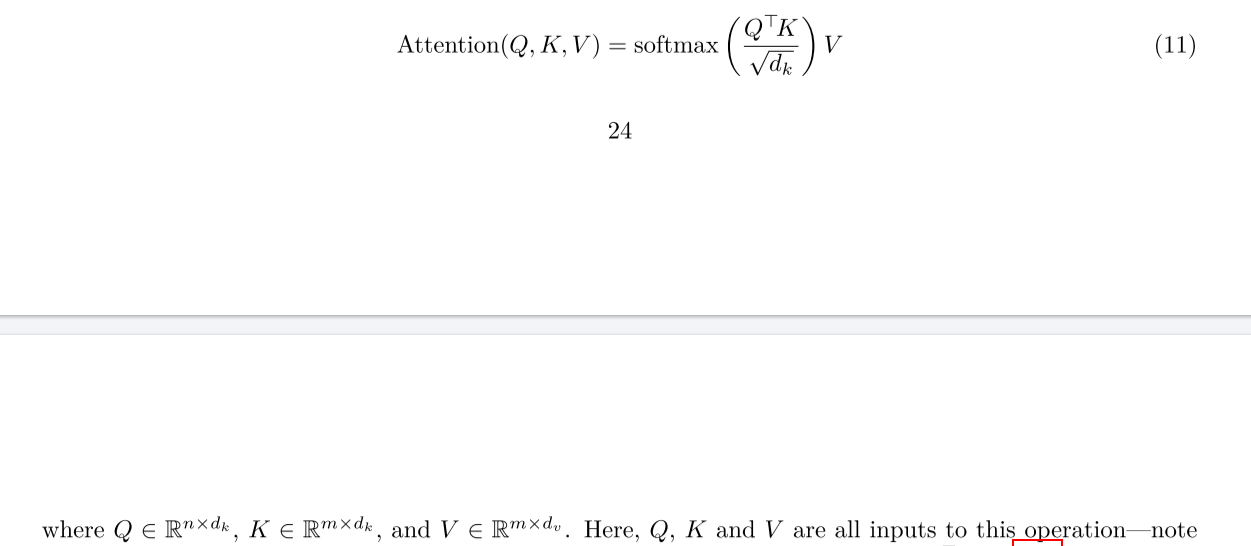
class ScaledDotProductAttention(nn.Module):def __init__(self,d_k: int):super().__init__()self.scale = 1.0 / math.sqrt(d_k)def forward(self,q: Float[torch.Tensor, "... seq_len_q d_k"],k: Float[torch.Tensor, "... seq_len_k d_k"],v: Float[torch.Tensor, "... seq_len_k d_v"],mask: Bool[torch.Tensor, "seq_len_q seq_len_k"] | None = None) -> Float[torch.Tensor, "... seq_len_q d_v"]:attention_score = einsum(q, k, "... seq_len_q d_k, ... seq_len_k d_k -> ... seq_len_q seq_len_k") * self.scaleif mask is not None:attention_score = attention_score.masked_fill(~mask, float("-inf"))attention_score = softmax(attention_score, dim=-1)return einsum(attention_score, v, "... seq_len_q seq_len_k, ... seq_len_k d_v -> ... seq_len_q d_v")
这里有个bug我d了10分钟,就是
tensor.masked_fill不是原地操作的,他的原地版本是tensor.masked_fill_,使用非原地操作的需要再赋一次值。
在adapters中调用
def run_scaled_dot_product_attention(Q: Float[Tensor, " ... queries d_k"],K: Float[Tensor, " ... keys d_k"],V: Float[Tensor, " ... values d_v"],mask: Float[Tensor, " ... queries keys"] | None = None,
) -> Float[Tensor, " ... queries d_v"]:"""Given key (K), query (Q), and value (V) tensors, returnthe output of your scaled dot product attention implementation.Args:Q (Float[Tensor, " ... queries d_k"]): Query tensorK (Float[Tensor, " ... keys d_k"]): Key tensorV (Float[Tensor, " ... values d_v"]): Values tensormask (Float[Tensor, " ... queries keys"] | None): Mask tensorReturns:Float[Tensor, " ... queries d_v"]: Output of SDPA"""model = layer.ScaledDotProductAttention(d_k=Q.shape[-1])return model(Q, K, V, mask=mask)
测试
pytest -k test_scaled_dot_product_attention
pytest -k test_4d_scaled_dot_product_attention

Causal Multi-Head Self-Attention
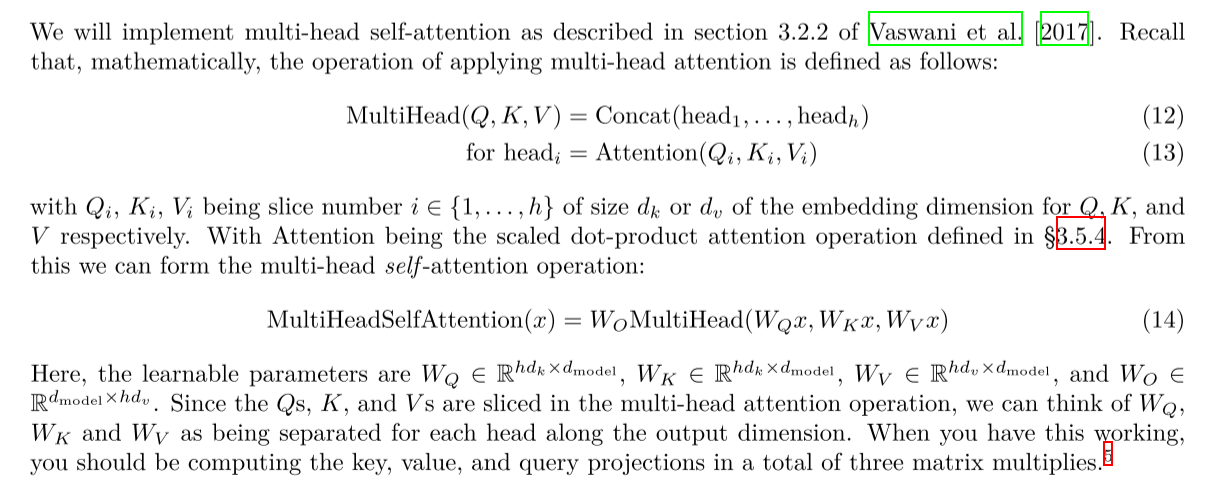
多头自注意力的实现是建立在前面点积注意力的基础上,这里新引入了4个线性层对模型进行线性变换,实现起来不难,但是有很多小细节。
class CausalMultiheadSelfAttention(nn.Module):def __init__(self,d_model: int,num_heads: int,max_seq_len: int | None = None,theta: float = 10000.0,use_rope: bool = True,device: torch.device | None = None,dtype: torch.dtype | None = None):super().__init__()assert d_model % num_heads == 0, "d_model can not divide num_heads"factory_kwargs = {'device': device, 'dtype': dtype}mask = torch.tril(torch.ones(max_seq_len, max_seq_len, dtype=torch.bool, device=device))self.mask = mask.unsqueeze(0).unsqueeze(0)self.d_model = d_modelself.num_heads = num_headsself.max_seq_len = max_seq_lenself.theta = thetaself.use_rope = use_ropeself.d_k = d_model // num_headsself.d_v = self.d_kself.attn = ScaledDotProductAttention(self.d_k)self.q_proj, self.k_proj, self.v_proj, self.o_proj = [Linear(d_model, d_model, **factory_kwargs) for i in range(4)] if use_rope is True:self.rope = RotaryPositionalEmbedding(theta=theta,d_k=self.d_k,max_seq_len=max_seq_len,device=device)def forward(self, x: Float[torch.Tensor, "batch_size seq_len d_model"],token_positions: Int[torch.Tensor, " batch_size sequence_length"] | None = None,) -> Float[torch.Tensor, "batch_size seq_len d_model"]:B, S, _ = x.shape q, k, v = [rearrange(proj(x), 'b s (h d) -> b h s d', h = self.num_heads) for proj in [self.q_proj, self.k_proj, self.v_proj]]if self.use_rope is True:q, k = self.rope(q, token_positions), self.rope(k, token_positions)out = self.attn(q, k, v, self.mask[..., :S, :S])return self.o_proj(rearrange(out, 'b h s d -> b s (h d)'))
adapters,如果只是结果不对看看是不是忘记加载Wq, Wk, Wv, Wo这四个模型参数了
def run_multihead_self_attention(d_model: int,num_heads: int,q_proj_weight: Float[Tensor, " d_k d_in"],k_proj_weight: Float[Tensor, " d_k d_in"],v_proj_weight: Float[Tensor, " d_v d_in"],o_proj_weight: Float[Tensor, " d_model d_v"],in_features: Float[Tensor, " ... sequence_length d_in"],
) -> Float[Tensor, " ... sequence_length d_out"]:"""Given the key, query, and value projection weights of a naive unbatchedimplementation of multi-head attention, return the output of an optimized batchedimplementation. This implementation should handle the key, query, and value projectionsfor all heads in a single matrix multiply.This function should not use RoPE.See section 3.2.2 of Vaswani et al., 2017.Args:d_model (int): Dimensionality of the feedforward input and output.num_heads (int): Number of heads to use in multi-headed attention.max_seq_len (int): Maximum sequence length to pre-cache if your implementation does that.q_proj_weight (Float[Tensor, "d_k d_in"]): Weights for the Q projectionk_proj_weight (Float[Tensor, "d_k d_in"]): Weights for the K projectionv_proj_weight (Float[Tensor, "d_k d_in"]): Weights for the V projectiono_proj_weight (Float[Tensor, "d_model d_v"]): Weights for the output projectionin_features (Float[Tensor, "... sequence_length d_in"]): Tensor to run your implementation on.Returns:Float[Tensor, " ... sequence_length d_out"]: Tensor with the output of running your optimized, batched multi-headed attentionimplementation with the given QKV projection weights and input features."""device, dtype = in_features.device, in_features.dtypemodel = layer.CausalMultiheadSelfAttention(d_model=d_model, num_heads=num_heads, max_seq_len = in_features.size(-2),use_rope=False,device=device,dtype=dtype) model.load_state_dict({"q_proj.W": q_proj_weight,"k_proj.W": k_proj_weight,"v_proj.W": v_proj_weight,"o_proj.W": o_proj_weight,}, strict=False)return model(in_features)def run_multihead_self_attention_with_rope(d_model: int,num_heads: int,max_seq_len: int,theta: float,q_proj_weight: Float[Tensor, " d_k d_in"],k_proj_weight: Float[Tensor, " d_k d_in"],v_proj_weight: Float[Tensor, " d_v d_in"],o_proj_weight: Float[Tensor, " d_model d_v"],in_features: Float[Tensor, " ... sequence_length d_in"],token_positions: Int[Tensor, " ... sequence_length"] | None = None,
) -> Float[Tensor, " ... sequence_length d_out"]:"""Given the key, query, and value projection weights of a naive unbatchedimplementation of multi-head attention, return the output of an optimized batchedimplementation. This implementation should handle the key, query, and value projectionsfor all heads in a single matrix multiply.This version of MHA should include RoPE.In this case, the RoPE embedding dimension must be the head embedding dimension (d_model // num_heads).See section 3.2.2 of Vaswani et al., 2017.Args:d_model (int): Dimensionality of the feedforward input and output.num_heads (int): Number of heads to use in multi-headed attention.max_seq_len (int): Maximum sequence length to pre-cache if your implementation does that.theta (float): RoPE parameter.q_proj_weight (Float[Tensor, "d_k d_in"]): Weights for the Q projectionk_proj_weight (Float[Tensor, "d_k d_in"]): Weights for the K projectionv_proj_weight (Float[Tensor, "d_k d_in"]): Weights for the V projectiono_proj_weight (Float[Tensor, "d_model d_v"]): Weights for the output projectionin_features (Float[Tensor, "... sequence_length d_in"]): Tensor to run your implementation on.token_positions (Int[Tensor, " ... sequence_length"] | None): Optional tensor with the positions of the tokensReturns:Float[Tensor, " ... sequence_length d_out"]: Tensor with the output of running your optimized, batched multi-headed attentionimplementation with the given QKV projection weights and input features."""device, dtype = in_features.device, in_features.dtypemodel = layer.CausalMultiheadSelfAttention(d_model=d_model, num_heads=num_heads, theta=theta,use_rope=(token_positions is not None),max_seq_len=max_seq_len,device=device,dtype=dtype)model.load_state_dict({"q_proj.W": q_proj_weight,"k_proj.W": k_proj_weight,"v_proj.W": v_proj_weight,"o_proj.W": o_proj_weight,}, strict=False)return model(x=in_features, token_positions=token_positions)测试
pytest test_model.py::test_multihead_self_attention
pytest test_model.py::test_multihead_self_attention_with_rope
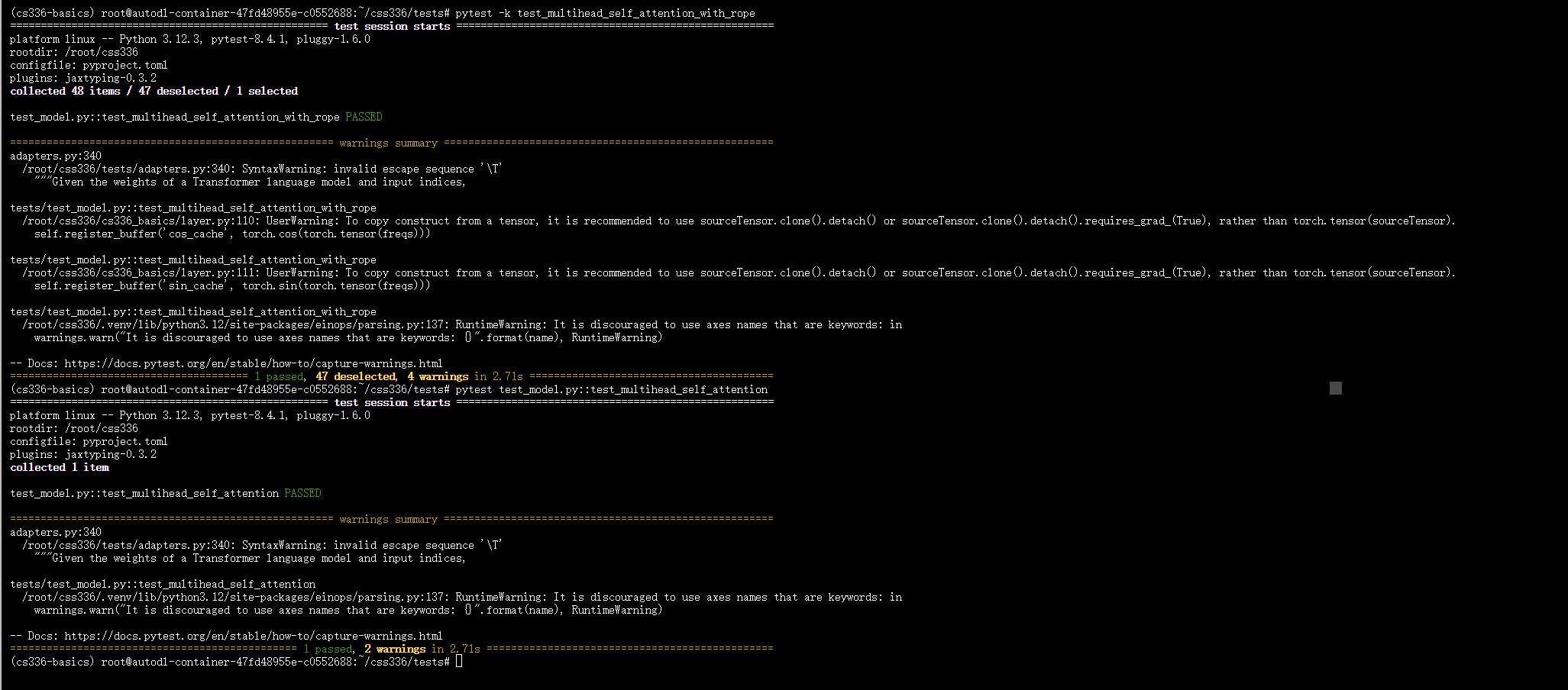
三、 The Full Transformer LM
Transformer block
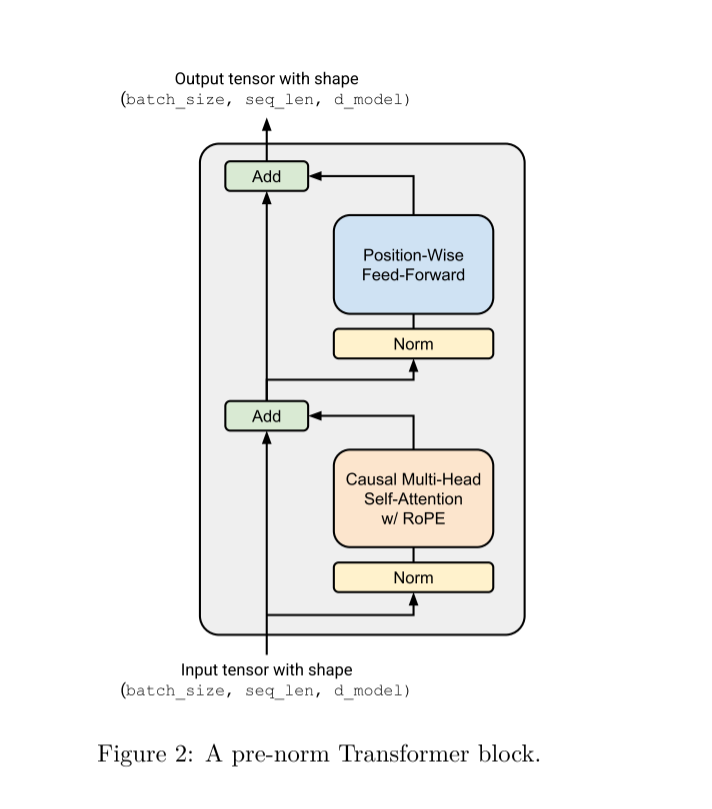
transformer block如上图所示,embedding x分成两条路线,一条通过RMSNorm再经过带有rope的causal MHA,另一条就是残差网络,直接和经过注意力路线的结果相加,然后得到的结果会再经过一个残差网络,残差网络还是先通过RMSNorm,再经过SiwshGLU,这构成了transformer block。
具体实现上就是将前面实现的模块组合到一起即可
class TransformerBlock(nn.Module):def __init__(self,d_model: int,num_heads: int,d_ff: int,max_seq_len: int,theta: float = 10000.0,use_rope: bool = True,device: torch.device | None = None,dtype: torch.dtype | None = None):super().__init__()kwargs = {"device": device, "dtype": dtype}self.d_model = d_modelself.num_heads = num_headsself.norm1 = RMSNorm(d_model=d_model,device=device,dtype=dtype)self.attn = CausalMultiheadSelfAttention(d_model=d_model,num_heads=num_heads,max_seq_len=max_seq_len,theta=theta,use_rope=use_rope,device=device,dtype=dtype)self.norm2 = RMSNorm(d_model=d_model,device=device,dtype=dtype)self.ffn = SwiGLU(d_model=d_model,d_ff=d_ff,device=device,dtype=dtype)def forward(self, x: Float[torch.Tensor, " batch seq_len d_model"],token_positions: Int[torch.Tensor, "batch seq_len"]) -> Float[torch.Tensor, " batch seq_len d_model"]:b, s, _ = x.shapeattn_out = self.attn(self.norm1(x), token_positions=token_positions)x = x + attn_outffn_out = self.ffn(self.norm2(x))x = x + ffn_outreturn x
这里有一个bug我调试了几个小时才发现,前面写的RMSNorm是有问题的,虽然单独的RMSNorm测试能通过但是组成Transformer block就会出问题。
class RMSNorm(nn.Module):def __init__(self,d_model: int,eps: float = 1e-5,device: torch.device | None = None,dtype: torch.dtype | None = None):super().__init__()self.d_model = d_modelself.eps = epsfactory_kwargs = {'device': device, 'dtype': dtype}self.W = nn.Parameter(torch.ones(d_model, **factory_kwargs))def forward(self, x: torch.Tensor) -> torch.Tensor:in_dtype = x.dtypex = x.to(torch.float32)RMS = (x.pow(2).mean(dim=-1, keepdim=True) + self.eps).sqrt()x /= RMSx *= self.Wreturn x.to(in_dtype)
上面是之前的实现在forward的过程中我直接进行了下面操作,这是会有问题的
x /= RMS
因为残差网络的原因,x + attn(Norm(x)),RMSNorm对x进行归一化会导致第一个x也被进行了归一化,因为上面是原地操作的,这就和要求的数据流动不一样,我们希望第一个x是没有经过任何处理的,这样残差连接才能起到作用,保证梯度流畅。
于是进行了下面的修改
class RMSNorm(nn.Module):def __init__(self,d_model: int,eps: float = 1e-5,device: torch.device | None = None,dtype: torch.dtype | None = None):super().__init__()self.d_model = d_modelself.eps = epsfactory_kwargs = {'device': device, 'dtype': dtype}self.W = nn.Parameter(torch.ones(d_model, **factory_kwargs))def forward(self, x: torch.Tensor) -> torch.Tensor:in_dtype = x.dtypex = x.to(torch.float32)RMS = (x.pow(2).mean(dim=-1, keepdim=True) + self.eps).sqrt()normalized_x = x / RMSresults = normalized_x * self.Wreturn results.to(in_dtype)
adapters
def run_transformer_block(d_model: int,num_heads: int,d_ff: int,max_seq_len: int,theta: float,weights: dict[str, Tensor],in_features: Float[Tensor, " batch sequence_length d_model"],
) -> Float[Tensor, " batch sequence_length d_model"]:device, dtype = in_features.device, in_features.dtypemodel = layer.TransformerBlock(d_model=d_model,num_heads=num_heads,d_ff=d_ff,use_rope=True,max_seq_len=max_seq_len,theta=theta,device=device,dtype=dtype)model.load_state_dict({"attn.q_proj.W": weights["attn.q_proj.weight"],"attn.k_proj.W": weights["attn.k_proj.weight"],"attn.v_proj.W": weights["attn.v_proj.weight"],"attn.o_proj.W": weights["attn.output_proj.weight"],"norm1.W": weights["ln1.weight"],"norm2.W": weights["ln2.weight"],"ffn.linear1.W": weights["ffn.w1.weight"],"ffn.linear2.W": weights["ffn.w2.weight"],"ffn.linear3.W": weights["ffn.w3.weight"]}, strict=False)B, S, _ = in_features.shapepositions = torch.arange(S, device=device).expand(B, -1)assert S <= max_seq_len, f"Sequence length {S} exceeds max_seq_len {max_seq_len}"return model(in_features, token_positions=positions)
测试
pytest test_model.py::test_transformer_block

调试这个bug的时候调了3 4个小时一度给我调自闭了,相信jyy的三公理:
- 机器永远是对
- 没有测试的程序永远是错的
- 当一项工作令你感到tedious的时候,一定有更高效的解决方法
Transformer LM
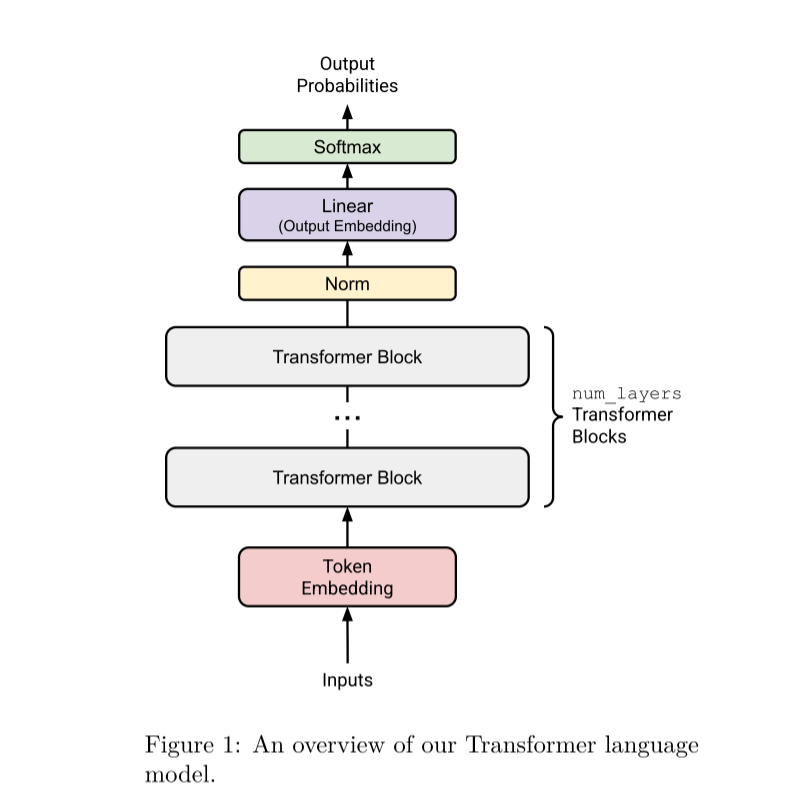
现在我们需要将整个Transformer language model给组合起来,即数据从被tokenizer划分成token_ids后开始处理,知道最后得到预测下一个词的logits。
有个点需要注意的是这里经过最后的Linear后不能再经过softmax不然会无法通过测试样例。
def _copy_param(target: torch.Tensor, source: torch.Tensor) -> None:"""Copy `source` into `target` in-place, transposing `source` if thatis what makes the shapes line up."""if source.shape == target.shape:target.data.copy_(source)elif source.T.shape == target.shape:target.data.copy_(source.T)else:raise ValueError(f"Shape mismatch: cannot load parameter of shape {source.shape} "f"into tensor of shape {target.shape}")class TransformerLM(nn.Module):def __init__(self,vocab_size: int,context_length: int,d_model: int,num_layers: int,num_heads: int,d_ff: int,theta: float,device: torch.device | None = None,dtype: torch.dtype | None = None):super().__init__()self.vocab_size = vocab_sizeself.context_length = context_lengthself.d_model = d_modelself.num_layers = num_layersself.num_heads = num_headsself.d_ff = d_ffself.theta = thetafactory_kwargs = {"device": device, "dtype": dtype}self.emb = Embedding(num_embeddings=vocab_size,embedding_dim=d_model,**factory_kwargs)self.blocks = nn.ModuleList([TransformerBlock(d_model=d_model,num_heads=num_heads,d_ff=d_ff,max_seq_len=context_length,theta=theta,use_rope=True,**factory_kwargs,)for _ in range(num_layers)])self.final_norm = RMSNorm(d_model=d_model,device=device,dtype=dtype)self.final_linear = Linear(in_features=d_model, out_features=vocab_size, **factory_kwargs)def forward(self, token_ids: Int[torch.Tensor, "batch seq_len"]) -> Float[torch.Tensor, "batch seq_len vocab_size"]:B, S = token_ids.shapeassert S < self.context_length, "text is too long"x = self.emb(token_ids)pos = torch.arange(S).unsqueeze(0).expand(B, S)for block in self.blocks:x = block(x, pos)x = self.final_norm(x)x = self.final_linear(x)# logits = softmax(x, dim=-1)return x
adapters的编写
def run_transformer_lm(vocab_size: int,context_length: int,d_model: int,num_layers: int,num_heads: int,d_ff: int,rope_theta: float,weights: dict[str, Tensor],in_indices: Int[Tensor, " batch_size sequence_length"],
) -> Float[Tensor, " batch_size sequence_length vocab_size"]:"""Given the weights of a Transformer language model and input indices,return the output of running a forward pass on the input indices.This function should use RoPE.Args:vocab_size (int): The number of unique items in the output vocabulary to be predicted.context_length (int): The maximum number of tokens to process at once.d_model (int): The dimensionality of the model embeddings and sublayer outputs.num_layers (int): The number of Transformer layers to use.num_heads (int): Number of heads to use in multi-headed attention. `d_model` must beevenly divisible by `num_heads`.d_ff (int): Dimensionality of the feed-forward inner layer (section 3.3).rope_theta (float): The RoPE $\Theta$ parameter.weights (dict[str, Tensor]):State dict of our reference implementation. {num_layers} refers to aninteger between `0` and `num_layers - 1` (the layer index).The keys of this dictionary are:- `token_embeddings.weight`Token embedding matrix. Shape is (vocab_size, d_model).- `layers.{num_layers}.attn.q_proj.weight`The query projections for all `num_heads` attention heads.Shape is (num_heads * (d_model / num_heads), d_model).The rows are ordered by matrices of shape (num_heads, d_k),so `attn.q_proj.weight == torch.cat([q_heads.0.weight, ..., q_heads.N.weight], dim=0)`.- `layers.{num_layers}.attn.k_proj.weight`The key projections for all `num_heads` attention heads.Shape is (num_heads * (d_model / num_heads), d_model).The rows are ordered by matrices of shape (num_heads, d_k),so `attn.k_proj.weight == torch.cat([k_heads.0.weight, ..., k_heads.N.weight], dim=0)`.- `layers.{num_layers}.attn.v_proj.weight`The value projections for all `num_heads` attention heads.Shape is (num_heads * (d_model / num_heads), d_model).The rows are ordered by matrices of shape (num_heads, d_v),so `attn.v_proj.weight == torch.cat([v_heads.0.weight, ..., v_heads.N.weight], dim=0)`.- `layers.{num_layers}.attn.output_proj.weight`Weight of the multi-head self-attention output projectionShape is ((d_model / num_heads) * num_heads, d_model).- `layers.{num_layers}.ln1.weight`Weights of affine transform for the first RMSNormapplied in the transformer block.Shape is (d_model,).- `layers.{num_layers}.ffn.w1.weight`Weight of the first linear transformation in the FFN.Shape is (d_model, d_ff).- `layers.{num_layers}.ffn.w2.weight`Weight of the second linear transformation in the FFN.Shape is (d_ff, d_model).- `layers.{num_layers}.ffn.w3.weight`Weight of the third linear transformation in the FFN.Shape is (d_model, d_ff).- `layers.{num_layers}.ln2.weight`Weights of affine transform for the second RMSNormapplied in the transformer block.Shape is (d_model,).- `ln_final.weight`Weights of affine transform for RMSNorm applied to the output of the final transformer block.Shape is (d_model, ).- `lm_head.weight`Weights of the language model output embedding.Shape is (vocab_size, d_model).in_indices (Int[Tensor, "batch_size sequence_length"]) Tensor with input indices to run the language model on. Shape is (batch_size, sequence_length), where`sequence_length` is at most `context_length`.Returns:Float[Tensor, "batch_size sequence_length vocab_size"]: Tensor with the predicted unnormalizednext-word distribution for each token."""first_val = next(iter(weights.values()))device, dtype = in_indices.device, first_val.dtypemodel = layer.TransformerLM(vocab_size=vocab_size,context_length=context_length,d_model=d_model,num_layers=num_layers,num_heads=num_heads,d_ff=d_ff,theta=rope_theta,device=device,dtype=dtype).eval() from layer import _copy_paramwith torch.no_grad():# (a) token embedding (also implicitly ties lm_head)_copy_param(model.emb.W, weights["token_embeddings.weight"])# (b) per-layer parametersfor layer_idx in range(num_layers):pfx = f"layers.{layer_idx}."block = model.blocks[layer_idx]# ── attention projections_copy_param(block.attn.q_proj.W, weights[pfx + "attn.q_proj.weight"])_copy_param(block.attn.k_proj.W, weights[pfx + "attn.k_proj.weight"])_copy_param(block.attn.v_proj.W, weights[pfx + "attn.v_proj.weight"])_copy_param(block.attn.o_proj.W, weights[pfx + "attn.output_proj.weight"])# ── RMSNorm weights_copy_param(block.norm1.W, weights[pfx + "ln1.weight"])_copy_param(block.norm2.W, weights[pfx + "ln2.weight"])# ── feed-forward (SwiGLU) weights_copy_param(block.ffn.linear1.W, weights[pfx + "ffn.w1.weight"])_copy_param(block.ffn.linear2.W, weights[pfx + "ffn.w2.weight"])_copy_param(block.ffn.linear3.W, weights[pfx + "ffn.w3.weight"])# (c) final layer-norm_copy_param(model.final_norm.W, weights["ln_final.weight"])# (d) (optional) make sure tied output embedding matches lm_head if provided_copy_param(model.final_linear.W, weights["lm_head.weight"])# 3) run the forward pass and return logitswith torch.no_grad():return model(in_indices) # (batch, seq_len, vocab_size)测试命令
pytest test_model.py::test_transformer_lm
测试结果:

四、 总结
感觉transformer LM 架构更像是在搭乐高一样,不过实现的时候还是有很多细节,以及einops、pytorch语法上的使用、以及jaxtype。
测试本章所有模块
pytest test_model.py
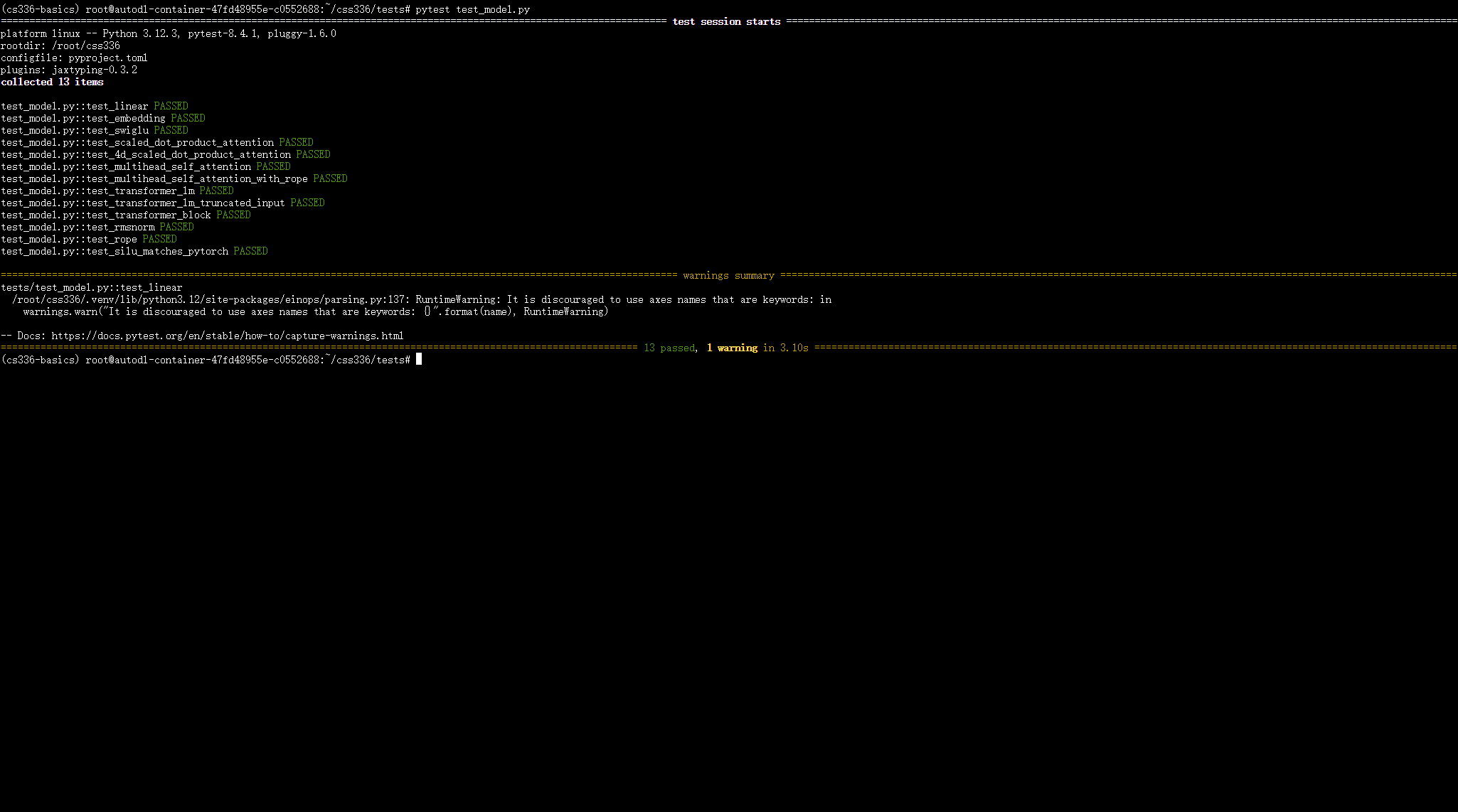
最后完结撒花~~~~
完整代码放在github仓库,如果有需要可以start一下!!!
github仓库
